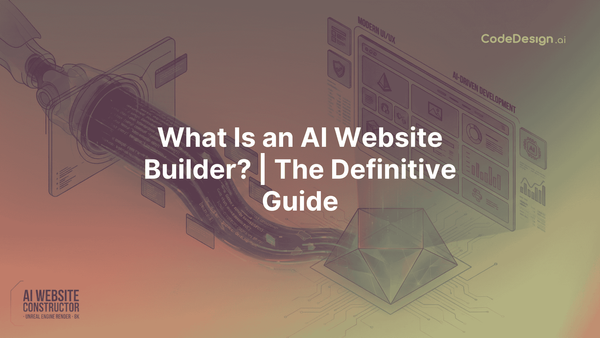A 7-Step Guide to Turning Your CodeDesign.ai Traffic into Revenue

You’ve done the hard part. You used CodeDesign.ai to build a stunning, professional website. Your marketing is driving traffic, your ads are running, and your SEO is bringing in new visitors.
But here’s the painful truth: traffic doesn’t equal revenue.
If your website visitors browse but don't buy, sign up, or book a demo, all that effort is wasted. This is why learning how to improve your website conversion rate is critical. It’s the difference between a website people visit and a business people buy from.
This is where Conversion Rate Optimization (CRO) comes in. CRO is the systematic process of increasing the percentage of website visitors who take a desired action.
This isn't just theory. It's a step-by-step process you can follow. And the CodeDesign.ai platform is built with all the tools you need to implement a powerful CRO strategy, letting you make changes and run tests in minutes, not weeks.
Table of Contents
- Research & Audit - Build Your Baseline
- Prioritize High-Impact Pages
- Optimize User Experience (UX) and Page Speed
- Craft Irresistible Calls-to-Action (CTAs)
- Simplify and Streamline Your Forms
- Test & Experiment with A/B Testing
- Track, Learn & Improve (Repeat)
1. Research & Audit - Build Your Baseline

You can't fix what you don't measure. Before you change a single button in the CodeDesign.ai editor, you must understand your current performance. A thorough audit is the foundation of your entire CRO strategy.
How to Uncover Hidden Issues:
- Audit Your Analytics: Easily integrate tools like Google Analytics with your CodeDesign.ai site. Confirm your goals (e.g., form submissions, demo requests) are tracking correctly.
- Map the User Journey: Identify your most common user paths. Where do they enter? More importantly, where do they drop off?
- Collect Qualitative Data: Use heatmaps (like Hotjar) to see where users click and scroll. Run polls and exit-intent surveys to ask visitors why they are leaving.
Quick CRO Wins:
- Fix any broken links or non-working CTAs.
- Ensure your analytics tracking is accurate.
- Install heatmap and session-recording tools for visual feedback.
2. Prioritize High-Impact Pages
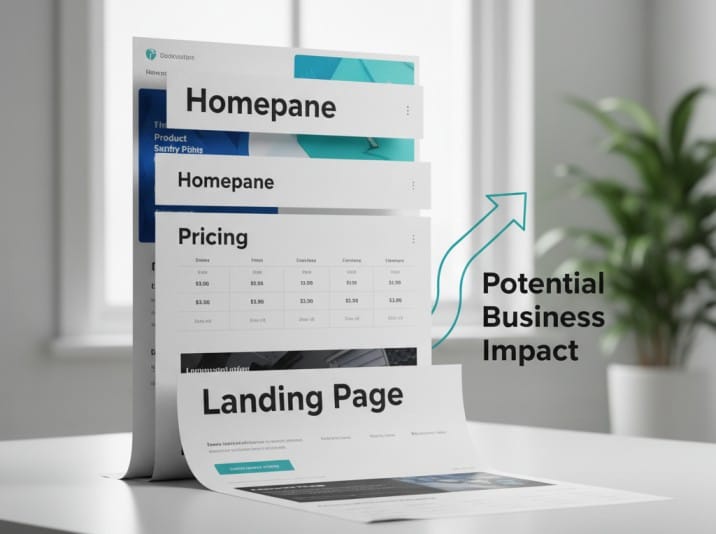
Not all pages are created equal. An update to your "About Us" page won't have the same impact as an update to your checkout page. Focus your limited time and resources on the pages that have the most direct influence on your revenue.
Where to Focus Your Efforts First:
- Homepage: Your site's front door.
- Pricing Pages: Where high-intent visitors make decisions.
- Product/Service Pages: Where you make your value proposition.
- Landing Pages: Key entry points from your ad campaigns.
- Checkout/Demo Request Forms: The final step where most "leaks" happen.
Quick CRO Wins:
- Analyze the high-priority pages with the highest bounce rates—these are your biggest opportunities.
- Ensure the primary CTA on each page is "above the fold" (visible without scrolling).
3. Optimize User Experience (UX) and Page Speed

Friction is the number one killer of conversions. If your site is slow, confusing, or hard to use on a phone, visitors will leave and go to a competitor.
How to Remove Friction:
- Page Speed: CodeDesign.ai gives you a massive head start here. Our platform automatically compresses images and serves your site from a global CDN to ensure lightning-fast load times. You can double-check your score with Google's PageSpeed Insights.
- Mobile-First Design: All CodeDesign.ai templates are fully responsive, but you should still test your site on your own phone. Can you easily read the text, click the buttons, and fill out the forms?
- Clear Navigation: Ensure your menu is simple and descriptive. A confused visitor will not convert.
Quick CRO Wins:
- Use the CodeDesign.ai editor's mobile preview to check your site's usability.
- Increase the font size and button size on mobile for easy tapping.
- Simplify your main navigation to 5 key items or fewer.
4. Craft Irresistible Calls-to-Action (CTAs)
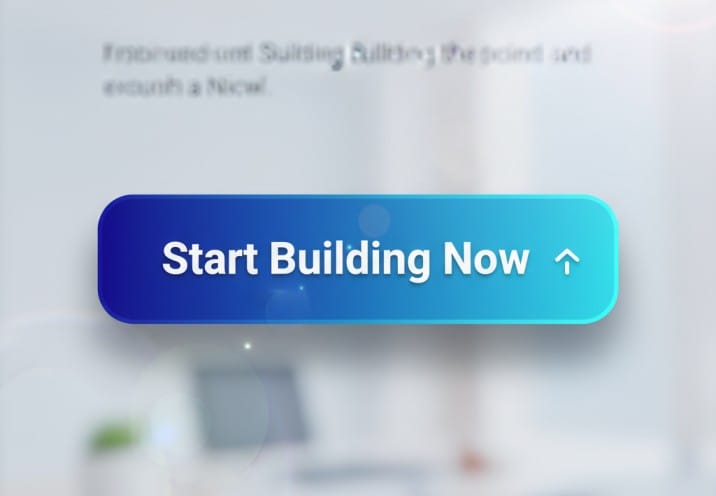
A passive website gets passive results. Your site's job is to actively guide the visitor to the next step. This is done with clear, compelling, and unmissable Calls-to-Action (CTAs).
Turning Passive Browsers into Active Leads:
- Make it Obvious: Your primary CTA button should be a contrasting color that stands out from the rest of your page. Use the CodeDesign.ai editor to test colors in seconds.
- Use Action-Oriented, Value-Driven Text: "Submit" is boring. "Learn More" is vague. Try "Get Your Free Demo," "Start My 7-Day Trial," or "Download the Free Ebook."
- Place it Strategically: Have a clear CTA above the fold and repeat it further down the page for longer content.
Quick CRO Wins:
- Change your main CTA button color to be the most high-contrast element on the page.
- Re-word your primary CTA text to focus on the value the user is getting.
- Add a secondary, lower-stakes CTA (like "See a 2-min demo video") for visitors who aren't ready to commit.
5. Simplify and Streamline Your Forms
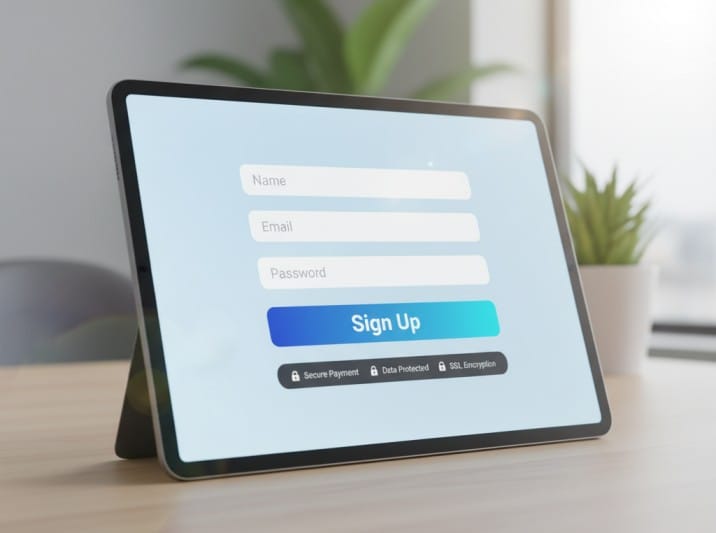
This is a huge one. Every single field you add to a form increases friction and reduces your conversion rate. If your contact form looks like a tax return, visitors will abandon it.
How to Validate Your Ideas with Data:
- Be Ruthless: Only ask for the information you absolutely need. Do you really need a phone number for a newsletter signup?
- Use the Right Fields: Use single-click options like radio buttons or dropdowns instead of making users type.
- Build Trust: Add a small note under the form stating you won't spam them or sell their data.
Quick CRO Wins:
- Log into CodeDesign.ai and remove 1-2 non-essential fields from your main contact or sign-up form right now.
- If your form is long, use the CodeDesign.ai form builder to break it into a simple, multi-step process.
- Clearly label each field and show error messages in-line.
6. Test & Experiment
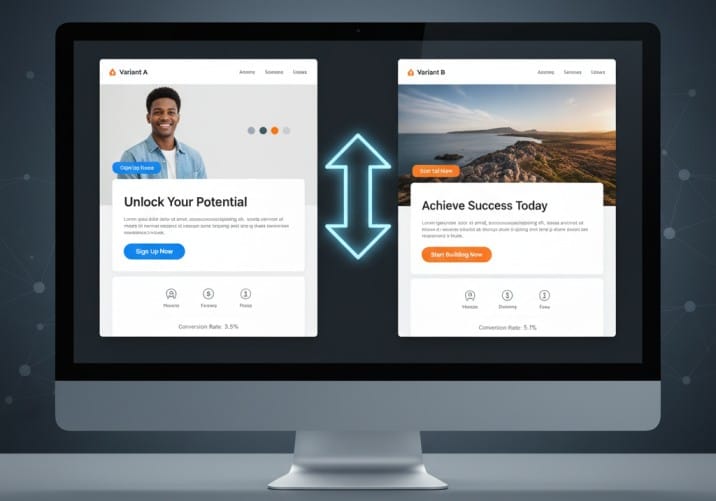
Conversion Rate Optimization is a science. Don't rely on guesswork or "best practices." What works for one audience may not work for yours. The only way to know for sure is to test.
Expanding What Already Works:
- Form a Hypothesis: Start with a clear idea (e.g., "Changing our hero image to a video will increase demo requests").
- Run A/B Tests: Use the CodeDesign.ai editor to easily duplicate a landing page. Change one element (the headline, the CTA, the image). Send 50% of your ad traffic to version A and 50% to version B.
- Measure and Learn: Run the test long enough to get a statistically significant result. Whether you win or lose, you've learned something valuable.
Quick CRO Wins:
- Test your main headline: "AI Website Builder" vs. "Build Your Business Website in 2 Minutes."
- Test your CTA button text: "Get Started" vs. "Start Building for Free."
- Test replacing a stock image with a real photo of your team or product.
7. Track, Learn & Improve (Repeat)

CRO is not a "one and done" project. It's an ongoing process. Customer expectations change, new competitors emerge, and your own products evolve. The key is to create a continuous loop of improvement: Research -> Test -> Measure -> Learn -> Repeat.
Your Platform for Continuous Conversion
The biggest advantage of using CodeDesign.ai isn't just building your site—it's the power to improve it. Unlike traditional websites that require a developer for every change, our visual editor empowers you to act on your data instantly.
See in your heatmap that no one is clicking a button? Log in and move it. Have a great idea for a new headline? A/B test it this afternoon, not next quarter.
Ready to Stop Losing Visitors and Start Converting Them?
By following these 7 steps, you can systematically turn your CodeDesign.ai website into a powerful conversion engine.
Stop letting valuable, hard-earned traffic slip away. Start turning those visitors into customers.
Log In to Your CodeDesign.ai Account and Start Optimizing Today
Frequently Asked Questions (FAQs)
1. What is a good website conversion rate?
This varies wildly by industry. E-commerce might see 2-3%, while B2B SaaS might aim for 5-10% on a targeted landing page. The most important thing is not to compare yourself to others, but to establish your own baseline and focus on improving it every month.
2. What are the most important CRO implementation steps?
The most critical steps are:
- Research: Understanding why users aren't converting through analytics and heatmaps.
- Simplifying: Removing friction, especially in your forms and navigation.
- Testing: Continuously experimenting with your headlines, CTAs, and page layouts to find what works for your audience.
3. How much does page speed affect conversions?
Massively. Studies show that even a 1-second delay in page load time can reduce conversions by 7% or more. A slow site feels unprofessional and frustrating, causing users to leave. This is why the optimized, high-speed infrastructure of CodeDesign.ai is a built-in conversion advantage.




